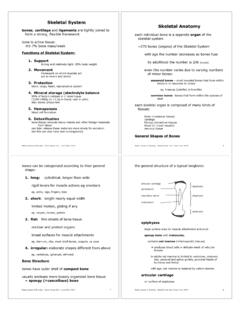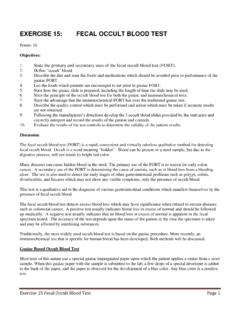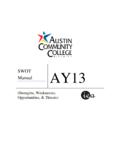Transcription of Reproductive System Anatomy of Male …
1 human Anatomy & Physiology: Reproductive System ; Ziser Lecture Notes, 1 Reproductive System Function: producing offspring propagation of the species !in terms of evolution the only reason all the other systems exist only major System that doesn t work continuously ! only activated at puberty unlike most other organisms on planet ! mammals only reproduce sexually humans are dieocious ! separate sexed (many animals are monoecious or hermaphrodites) in 7th week of embryonic development genes are activated that trigger differentiation of gonads human Anatomy & Physiology: Reproductive System ; Ziser Lecture Notes, 2 Anatomy of Male Reproductive System Major Organs External Reproductive Organs penis and scrotum Internal Organs: these structures form continuous tube: Testes epididymus vas deferens ejaculatory duct urethra in penis Accessory organs seminal vesicles prostate gland bulbourethral glands 1. Penis and Scrotum penis is transfer organ glans !
2 Expanded head prepuce ! foreskin both have modified sebaceous glands that produce waxy secretion = smegma human Anatomy & Physiology: Reproductive System ; Ziser Lecture Notes, 3 penis contains erectile tissues that surrounds the urethra ! fill with blood during sexual arousal corpus spongiosum (lower surrounds urethra) passes along ventral side of penis and encloses urethra 2 coropora cavernosum (upper) on dorsal side all contain numerous tiny blood sinuses = lacunae scrotum keeps testes at cooler temperature ! sperm can only be produced at several degrees below normal body temp 2. Testes (=testicles) primary Reproductive organ of male testis enclosed by white fibrous capsule interior is divided into several hundred lobules divided by septa each lobule contains: human Anatomy & Physiology: Reproductive System ; Ziser Lecture Notes, 4 a. seminiferous tubules (700 of seminiferous tubules in testes) !
3 Functions in spermatogenesis: formation and maturation of sperm cells in cross section: seminiferous tubules appear roughly circular and contain germinal epithelium (containing germ cells) and sustentacular (Sertoli) cells Sertoli cells protect germ cells and promote their development b. interstitial cells are scattered between the seminiferous tubules function in hormone secretion !testosterone 1. development and maintenance of secondary sexual characteristics 2. stimulates protein synthesis 3. promotes growth of skeletal muscles 3. Epididymis epididymis is highly coiled, 18 tube that sits on outside of testes human Anatomy & Physiology: Reproductive System ; Ziser Lecture Notes, 5 takes sperm about 20 days to make their way through the epididymus when sperm enter epididymis they are immature, nonmotile and incapable of fertilization !epididymis is a site of maturation !
4 Then are stored until duty calls stored sperm remain fertile for 40-60 days older sperm disintegrate and are reabsorbed by epididymis 4. Vas Deferens (=Ductus Deferens) a long muscular tube leading from eipdidymis in scrotum, through the inguinal canal into the pelvic cavity and around the posterior side of the bladder where it unites with ducts from the seminal vesicles 5. Ejaculatory Duct ducts from seminal vesicles join vas deferens to form a short ejaculatory duct that passes through the prostate gland and joins the urethra 6. Urethra human Anatomy & Physiology: Reproductive System ; Ziser Lecture Notes, 6 ejaculatory duct connects with urethra inside the prostate gland urethra opens to outside via the penis Accessory Organs three accessory glands secrete fluids that mix with the sperm = semen 1. Seminal Vesicles (paired) pair of glands dorsal to bladder, each ~5 cm long secrete viscous yellowish liquid rich in fructose, prostaglandins and other nutrients that comprises ~60% of the semen fructose serves as energy source for sperm 2.
5 Prostate Gland (single) inferior to bladder, ~3 cm diameter (size of golf ball) surrounds ejaculatory duct at junction with urethra resembles a sponge; walls have >30 orifices secretes a thin, milky, liquid that contains citric human Anatomy & Physiology: Reproductive System ; Ziser Lecture Notes, 7 acid, calcium and various enzymes and constitutes ~30% of the semen this buffered solution (pH~ ) protects sperm from the acidity of male urethra and female vagina by age 70, most (90%) of men show some degree of benign prostatic hyperplasia ! can compress urethra, slow urine flow, promote bladder and kidney infections 3. Bulbourethral Glands (paired) small (~1cm) pea-shaped glands below prostate during sexual arousal they produce a clear, slippery fluid that lubricates the head of the penis in preparation for intercourse also protects sperm by helping to neutralize the acidity of residual urine in urethra during arousal some of this fluid may appear at tip of penis and may contain sufficient sperm to fertilize the egg even without actual ejaculation human Anatomy & Physiology: Reproductive System ; Ziser Lecture Notes, 8 Anatomy of Female Reproductive System External Reproductive Organs: vulva mammary glands Internal Organs ovaries oviducts uterus vagina 1.
6 Vulva group of structures at external opening of vagina mons pubis labia majora labia minor clitoris (homologous to male penis) Bartholins gland (for lubrication, homologous to bulbourethral glands in males) functions: sensory arousal glands for lubrication 2. Breasts (Mammary Glands) nutrient rich food for nursing infant human Anatomy & Physiology: Reproductive System ; Ziser Lecture Notes, 9 in developing countries often the best meals a person gets in his/her lifetime ! diseases associated with cessation of nursing each breast consists of several lobes of secretory cells embedded in connective tissue ducts from individual glands unite to form single duct !duct exits through nipple 3. Ovaries cortex of ovaries are covered by layer of small epithelial cells = germinal epithelium below this layer 1000 s of follicles develop embedded in connective tissue matrix within follicles are partially developed egg cells ovaries perform two major functions: 1.
7 Oogenesis immature egg cells in ovary mature into ova ready for fertilization 2. hormone secretions human Anatomy & Physiology: Reproductive System ; Ziser Lecture Notes, 10 follicle cells in ovary secrete mainly estrogen and progesterone 4. Uterine Tubes (=oviducts, fallopian tubes) open at one end to receive the egg at ovulation opening is enlarged and partially surrounds ovary feathery projections = fimbriae fibriae, activated by hormones just before ovulation ! become filled with blood ! brush swollen follicle at ovulatioin ! draw egg into oviduct ciliated along its length and muscular wall to move egg down to uterus takes 3-4 days for egg to travel ~5 fertilization occurs here 5. Uterus a thick pear-shaped, muscular organ subdivided into: fundus = upper portion body = mid portion cervix = lower portion that extends into the vagina human Anatomy & Physiology: Reproductive System ; Ziser Lecture Notes, 11 receives egg from oviduct !
8 If fertilized, holds embryo and fetus during development 3 layers: epimetrium (=perimetrium, =visceral peritoneum) ! serous tissue myometrium ! muscle layers endometrium ! inner mucous lining ovaries and other internal Reproductive organs are held in place by several connective tissue ligaments: some are mainly extensions of peritoneum eg. ovarian ligament ! connects ovary to uterus eg. suspensory ligament ! connects ovary to pelvic wall eg. broad ligament ! encloses uterine tube and connects it to sides of uterus eg. round ligaments ! fibromuscular cords that help hold uterus in place 6. Vagina (birth canal) human Anatomy & Physiology: Reproductive System ; Ziser Lecture Notes, 12 leads to outside of body muscular tube wall is thin but very distendable mucosa secretes lubricating fluid during sexual arousal at its lower end, mucosa folds inward and forms a membrane = the hymen which is ruptured by strenuous activity, insertion of tampons as menstrual cycle begins or first intercourse not connected to urethra human Anatomy & Physiology: Reproductive System ; Ziser Lecture Notes, 13 Physiology of Male Reproductive System the anterior pituitary gland serves as the primary control of Reproductive function at puberty Ant Pituitary secretes FSH & large amounts of LH (ICSH) FSH & LH !
9 Cause testes to increase in size and begin sperm production LH ! triggers interstitial cells to produce testosterone the secretion of FSH and LH is fairly constant from day to day in males male hormone (=androgens) are secreted mainly by interstital cells of testes main male hormone is Testosterone There are two male hormones: testosterone androstenedione additional testosterone is secreted by Adrenal Cortex Testosterone functions: 1. local effects on sperm development in seminiferous tubules human Anatomy & Physiology: Reproductive System ; Ziser Lecture Notes, 14 decrease in testosterone can cause sterility 2. stimulates general protein synthesis 3. promotes muscular development, bone growth, thickening of skin and growth of facial and body hair 4. development and maintenance of secondary sexual characteristics hair pattern thickening of vocal cords and enlargement of larynx to lower of voice pitch 5. behavioral changes (~sex drive, aggression, courtship behaviors) Androgens are also produced in women ovary & adrenal cortex relatively weak promotes protein synthesis, growth not masculinizing Negative feedback loop maintains constant level of testosterone in blood: !
10 High testosterone levels inhibit LH human Anatomy & Physiology: Reproductive System ; Ziser Lecture Notes, 15 Spermatogenesis process of sperm production ! process takes ~ 70-80 days sperm are produced in seminiferous tubules Sertoli Cells = specialized cells in the seminiferous tubules facilitate spermatogenesis 1. produce a blood-testes barrier forms just before puberty protects developing sperm cells from certain proteins, hormones, ions and drugs that might damage sperm cells also keeps sperm from diffusing into the blood -mature sperm are very immunogenic 2. Nourish developing sperm cells they secrete fluid rich in proteins, enzymes and testosterone into the seminiferous tubules 3. also phagocytize any damaged sperm cells sperm develop from a type of stem cell =spermatogonia Steps of spermatogenesis: 1. during prenatal development primordial germ cells colonize embryonic gonad and become spermatogonia human Anatomy & Physiology: Reproductive System ; Ziser Lecture Notes, 16 2.









